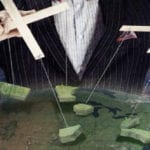10Maple Syrup
For those of us who just splash some maple syrup on the occasional pancake, it’s hard to imagine that anyone needs a Global Strategic Maple Syrup Reserve. But apparently, the Federation of Quebec Maple Syrup Producers runs their marketing co-op like OPEC. Sanctioned by the Canadian government, this private enterprise is run by powerful syrup producers who’ve cornered about 75 percent of the global market, which is worth hundreds of millions of dollars. Canadian syrup producers who don’t cooperate with the quota system often find themselves in legal hot water. In an interview with Al Jazeera America, a small Quebec producer described what happened to his family’s business: “The agent who came here to seize our syrup said, ‘If you were growing pot, we wouldn’t be giving you as much trouble.’ ” A Canadian syrup broker was more direct. “They’re like a mafia,” he told Al Jazeera. It’s such a soap opera that Hollywood wants to make a movie about a syrup heist at the reserve’s warehouse. Around the turn of the 21st century, the federation set up its strategic reserve to control supplies and set prices. The federation also controls marketing. They want to tout the “health benefits” of syrup to consumers in markets like the US, Australia, France, and Germany. Their goal is to convince people to replace other sweeteners like white sugar. Between 2011 and 2012, thieves snatched about 60 percent of the reserve, which was worth about $18 million at that time. Eventually, they were arrested, but the stolen syrup is harder to recover. As one Quebec police lieutenant told The New York Times, “Maple syrup doesn’t have a bar code. There’s no way to tell it apart.”
9Pork
China’s economy depends on a literal piggy bank. Until about the 1990s, most Chinese citizens ate meat so rarely that it only made up about 3 percent of their calories per year. They just couldn’t afford to eat better. Now, with China an economic contender, the average Chinese citizen eats about 40 kilograms (85 lb) of pork each year. In 2007, blue ear pig disease killed 45 million pigs in China. The rise in pork prices caused inflation throughout the economy. Panic buying had Chinese customers literally crushing each other to get scarce pork from supermarkets. The communist government became so concerned that they established a strategic pork reserve to stabilize prices. It includes both live pigs and frozen pork. When prices are too low, the government buys pork to make it scarcer and more expensive. When prices are too high, the government sells pork. These moves are more symbolic than anything else. The Chinese government can’t control enough pigs to affect prices on their own. But their signals influence what others do. The antibiotics added to this feed are creating superbugs among both animals and humans. Even the animals’ waste is causing a problem. There’s so much of it that it’s contributing to global warming.
8Helium
Most of us think of helium as the class clown of elements. You pump it into party balloons to make them lift off or inhale it to make your voice squeak. Other than that, it’s kind of just there—odorless, colorless, tasteless. After hydrogen, it’s the second most plentiful gas in the universe. So why does the US government have a federal stockpile of the stuff? Actually, the US created the Federal Helium Reserve in 1921 as a way to store helium for blimps, which were used as war weapons back then. But blimps didn’t become as important to air defense as the US initially imagined, so the blimp program was shuttered. But not the Federal Helium Reserve, which continued to grow near Amarillo, Texas, to about 11 billion cubic feet as of 2013. However, now it’s more about the government providing a critical product that private enterprise doesn’t want to sell as long as the market is controlled. Helium has unique qualities that put it in high demand. It’s an excellent coolant that stays liquid down to a temperature of absolute zero. Although it’s exceptionally light, helium doesn’t explode like hydrogen. It also has inert properties that are useful in arc welding. Helium is used in computer chips, fiber optic cables, MRI machines, aerospace technology, and scientific research. But even though it appears to be a common element, helium is actually rare on Earth in a usable form. Coupled with the US government’s desire to get out of the helium business, the limited supply—and increasing demand—could lead to skyrocketing prices for the industries that use this valuable element.
7Wine
It’s Business 101 or just plain common sense. If consumers have moved on to buying cars, you don’t produce more buggy whips in the hope that people will come back to your product someday. You change with the times or go bankrupt. Unless you were making wine in the EU from 1982 until 2008. Then, the government would have paid you to store your unwanted product in the EU’s “wine lake,” a surplus of “buggy whip” wine that consumers didn’t want but producers got paid to keep making anyway. These subsidies cost EU taxpayers about $1.7 billion per year. Especially in France and Italy, the overproduction of grapes that the market didn’t want sent supplies soaring and prices crashing. The New World was making the wines that consumers increasingly preferred, whether due to changing tastes or simply better marketing. In response, the EU purchased mostly lower-quality grapes for “crisis distillation” into the alcohol used for industrial alcohol and biofuels. This was supposed to restore equilibrium to the market. Instead, the subsidized growers continued to produce unwanted grapes, which kept the wine lake overflowing its banks. In 2008, the government tried a new approach called “grubbing up,” which paid growers to dig up vines and abandon fields with unwanted grapes. In 2013, there was a brief shortage of wine, but the surplus returned a year later.
6Cotton
As of late 2015, China had the biggest government stockpile of cotton at around 10 million tons (or 40 percent of the world’s stocks). No other country could match it, which is lucky for those countries. Chinese officials thought all that cotton would allow them to control the market, but they can’t make a move. It’s like they’re standing on top of the world’s largest cotton stockpile with a tight, cotton noose around their necks. They didn’t think it could hurt them. But if they reduce the stockpile too much or try to jump off, they’ll be left hanging and get killed economically. Originally, China built the stockpile to keep raw material prices low for their textile mills. The stockpile was also supposed to help China’s farmers. The government bought the farmers’ cotton at a controlled price—which was often above the market price—to guarantee the farmers a certain level of income. But it’s expensive to store all that cotton. To avoid making the stockpile bigger, the Chinese government stopped buying cotton in 2013. Instead, they now make direct payments to their farmers to compensate them for lower market prices. But the Chinese government still needs to get rid of their stockpile in a glutted market. They bought the cotton at artificially high prices, so they automatically lose money when they sell at the market price. Worse yet, the more they sell into a saturated market, the lower the price goes and the bigger their losses. Ignoring this disastrous history, India has stepped up purchases for its cotton stockpile to subsidize its farmers and textile mills like China once did. For some reason, the Indian government seems to be expecting a different result.
5Butter
After World War II, memories of economic collapse and food shortages were fresh in the minds of many Europeans. To ensure this didn’t happen again, the European Economic Community (the EEC, which is now the EU) developed the Common Agricultural Policy (CAP) in 1962 to subsidize its farmers. Under CAP, the government paid farmers artificially high prices for dairy products no one wanted, stopped their competition at the border with high taxes, and forced the European public to pay inflated prices for their food. Especially in the 1970s and ’80s, these unwanted dairy products were stored by the government in warehouses called “butter mountains” and “milk lakes.” In 1970, the CAP payments made up almost 90 percent of the EEC’s budget. That’s fallen to around 50 percent of the EU budget as of 2013, but it’s still an enormous amount of money to pay for farming activity that makes up less than 3 percent of the EU’s economy. Despite this, the EU avoided any serious reforms until the 1990s. To move away from paying farmers guaranteed minimum prices for unwanted food, the government has largely shifted to making direct payments to farmers so they won’t produce as much. Some of these payments come with conditions to protect the environment. The EU has eased some of its import restrictions, too. Even so, the government returned to the old policies in 2009 when the economy was struggling. The EU claimed it was a temporary measure that would result in a butter molehill, not a mountain. Critics argue that farming subsidies by rich nations hurt developing countries whose farmers can’t compete with these artificially low prices for food.
4Medical Supplies
If any area of the US is hit with an overwhelming emergency from a natural disaster, terrorist attack, or flu outbreak, the Strategic National Stockpile (SNS) can provide lifesaving medicines, vaccines, antidotes for chemical and biological attacks, and more. The SNS is not a first responder. But if a state or national agency requests help, the SNS can provide critical medical supplies in an emergency. Managed by the Centers for Disease Control (CDC), the SNS keeps its inventory divided between warehouses scattered across the US. That way, it should be able to respond within 12 hours to any emergency, no matter where it happens. If the threat isn’t well defined at first—for example, if an unusual cluster of deaths without a known cause or specific diagnosis overwhelms local medical facilities—the SNS sends “push packages,” which contain a broad spectrum of medications and other medical supplies. Once advisers arrive with these supplies at the scene of the emergency, responsibility is handed from the feds to the local authorities. Health care workers then distribute these supplies free of charge to the patients who need them. The SNS program has already responded to areas affected by the 9/11 attacks, the anthrax attacks in late 2001, and Hurricane Katrina in summer 2005. After Katrina, the CDC realized that they also needed to provide supplies for chronic diseases such as diabetes and high blood pressure to treat those patients who might be without their meds in long-term disasters.
3Sugar
The world’s sugar stockpiles are so high and prices so low that it’s driving some sugarcane farmers in India to commit suicide. Even with higher demand and lower production for sugar, the surplus in the sugar market is expected to remain high through 2016. That keeps sugar prices low and farmers hurting financially. Ironically, a major cause is the government-subsidized stockpiles of 86 million tons of sugar that were supposed to prop up prices and raise incomes for farmers of sugar crops. That strategy obviously backfired. Sugar prices have also been hurt by low oil prices, which reduced demand for ethanol, an alternative fuel which can be made from sugar crops. The US and China have had government stockpiles of sugar for years. In early 2015, India was debating whether a government-sponsored sugar stockpile would help its farmers weather the latest plunge in prices. But government stockpiles often cause more problems than they solve. In late 2013, China considered phasing out its stockpile in favor of making direct payments to farmers. “We have this dilemma,” said Chinese official Zhao Lihua at a local conference. “The more the government stockpiles when local supply exceeds demand, the worse the oversupply becomes because we end up importing more.”
2Rubber
Rubber stockpiles were once so important to the ability to wage war that Western countries devised secret missions to steal these stockpiles from their enemies. When World War II began, Japan seized Burma, Malaya, and the Dutch East Indies, cutting off the Allies’ access to about 90 percent of the supply of natural rubber. Without enough rubber for tanks, military aircraft, and military clothing, the Allies were at serious risk of losing the war. In the US, this sparked a political battle between those who favored natural rubber and those who wanted synthetic rubber. Some politicians like Henry Wallace worried that a synthetic rubber program could lead to dangerous policies of isolation and protection after the war. In The New York Times Magazine, he asked, “Will the rubber policies we adopt now lead to World War III later on?” In June 1940, President Franklin Roosevelt created the Rubber Reserve Company to stockpile rubber. Sponsored by the US government, several companies worked together to produce a synthetic rubber that saved the country from a critical shortage. The Allies also launched Operation Mickleham in the early 1940s, which was supposed to smuggle rubber from Japanese-occupied areas. But it was a comedy of errors that failed miserably. Today, rubber is less of a national security issue. In 2012, the US decided to sell its rubber stockpile. As of 2015, Thailand, Indonesia, and Malaysia are part of a consortium that produces about two-thirds of the world’s natural rubber. They’ve tried to control prices like OPEC once did, but they haven’t succeeded because of oversupply and flagging demand.
1Baton Rounds
Some UK citizens became concerned when the London Metropolitan Police began stockpiling baton rounds (aka rubber bullets), increasing their stash from about 700 before the London riots in August 2011 to over 10,000 just a few months later. According to a former police commander in an interview with the BBC, this massive increase suggested that the Met had become more willing to use baton rounds on the public. Coated with or made completely from plastic or rubber, baton rounds are meant to inflict pain on protesters or rioters without causing serious harm. The Home Office authorized their use by UK police in 2001, although security forces in Northern Ireland began using them as early as 1970. Originally, troops in Northern Ireland were supposed to fire at the ground from a long distance so the bullets would ricochet into the legs of protesters. But in some cases, the security forces fired into the heads and chests of individuals at close range, which killed or severely injured many people. One of those killed was Stephen McConomy at a demonstration in Northern Ireland in 1982. “My brother was just 11 years old when he was hit in the back of the head from just feet away,” said Stephen’s brother Emmett in an interview with the BBC. “It was so powerful, it threw him down the street.” The soldier who killed Stephen wasn’t prosecuted because it was believed to be an accidental shooting. In 2011, Tony Murray, a newspaper photographer covering a Belfast demonstration, was shot in the leg accidentally with a baton round. “It was like getting hit with a [sledgehammer],” he told the BBC. “It took weeks and weeks to recover.”
























